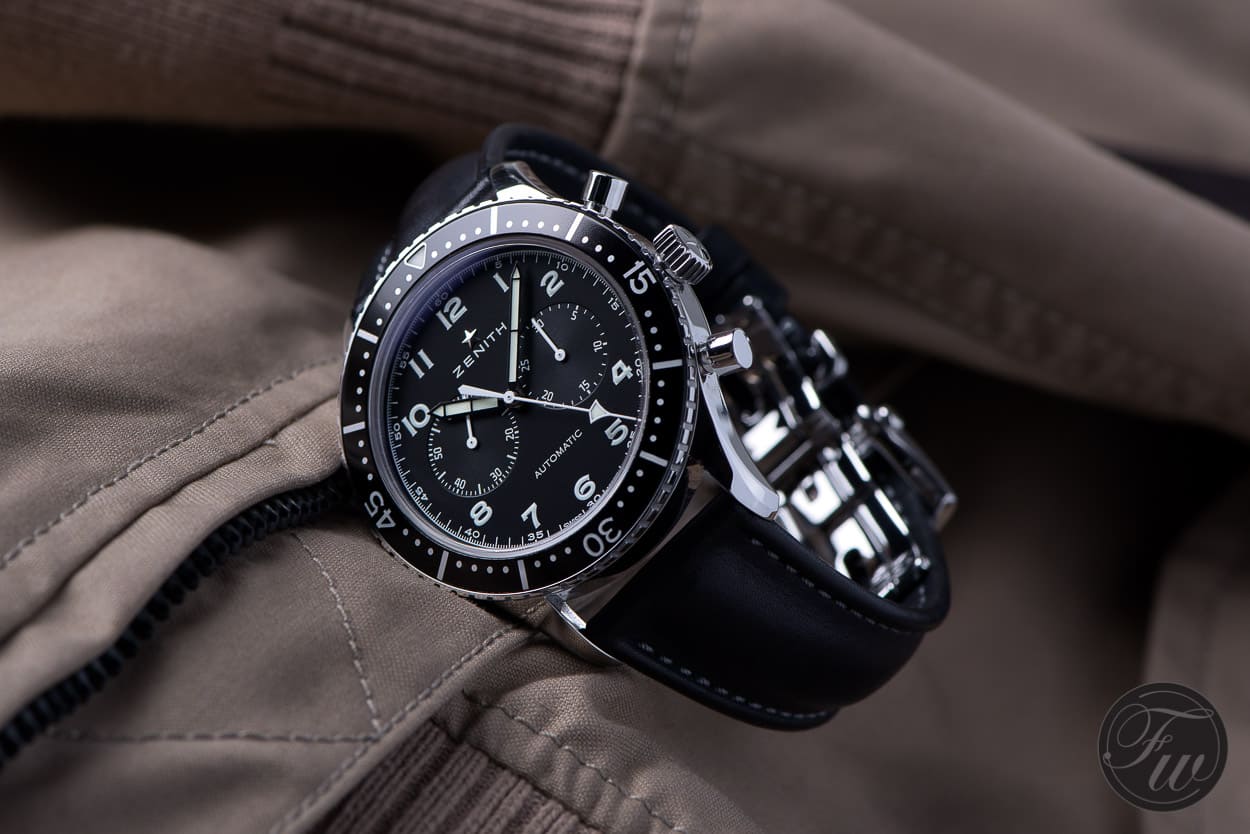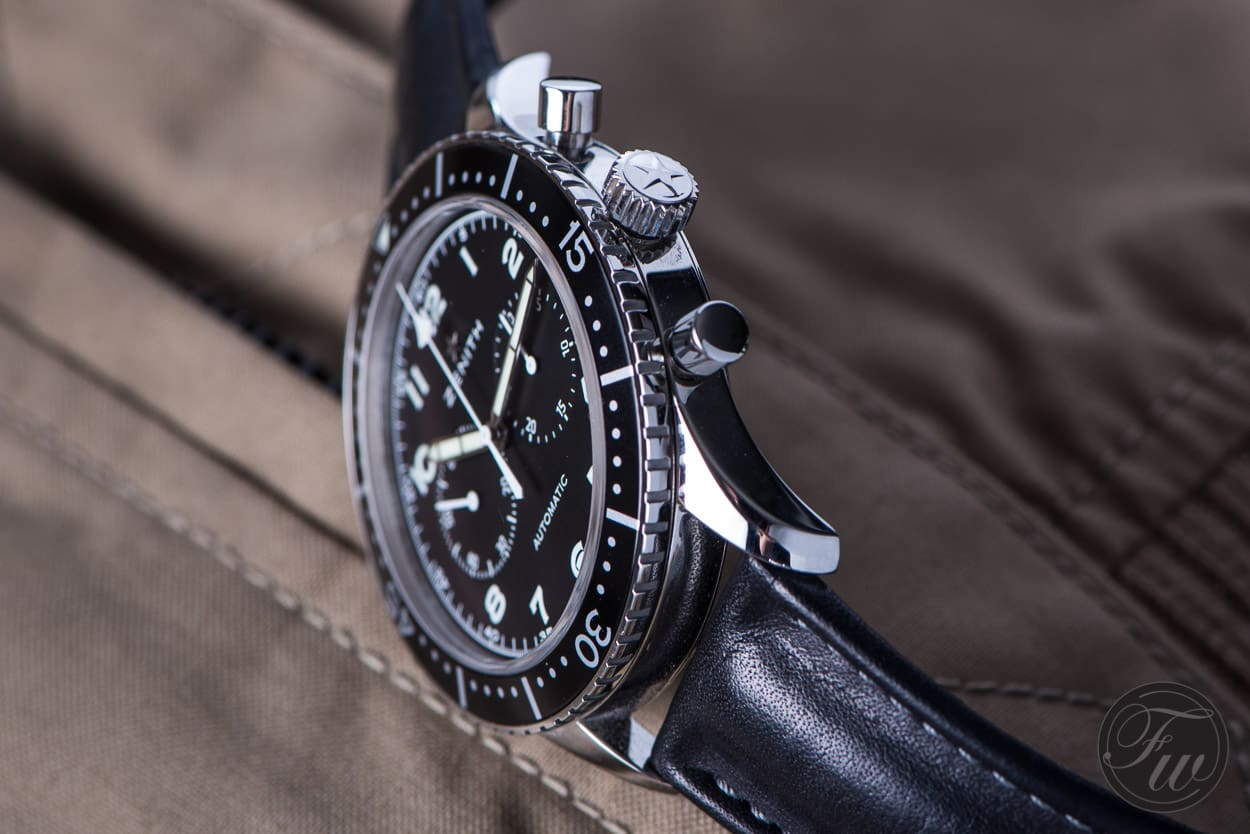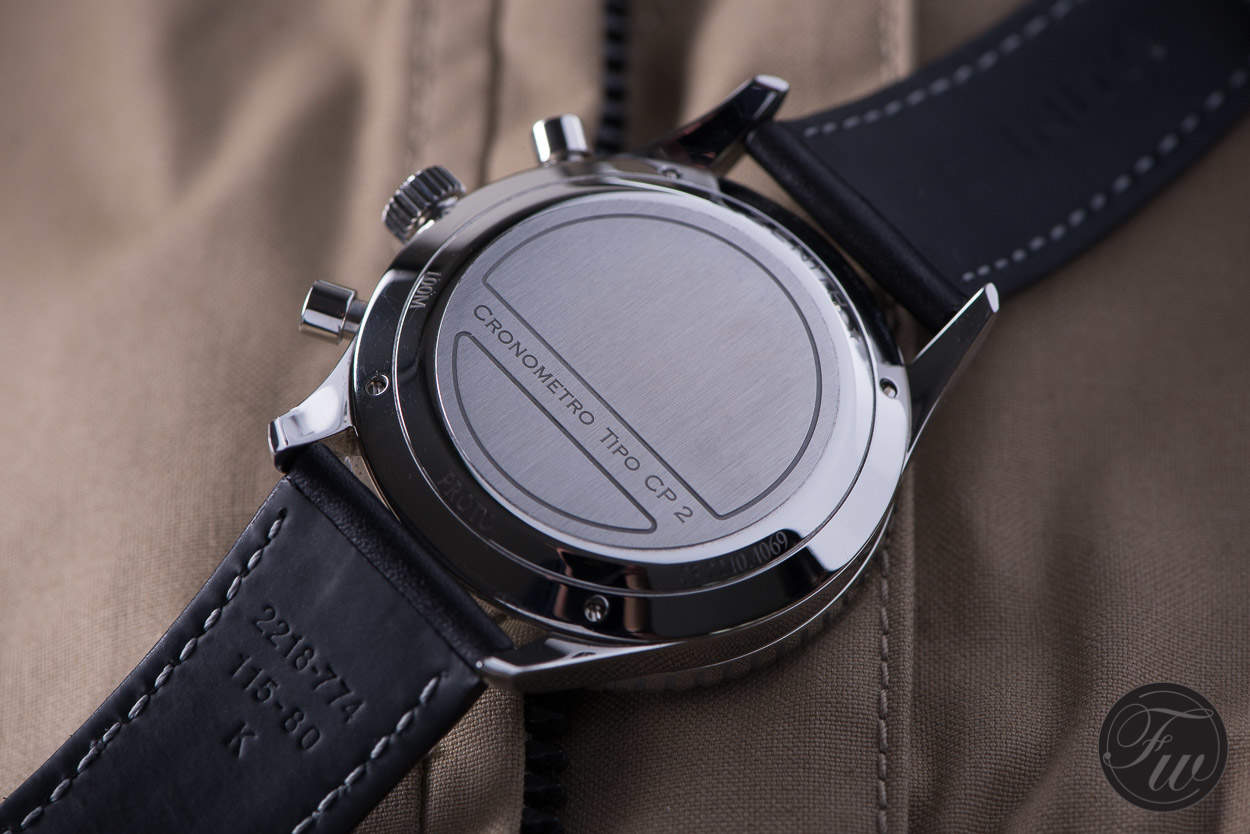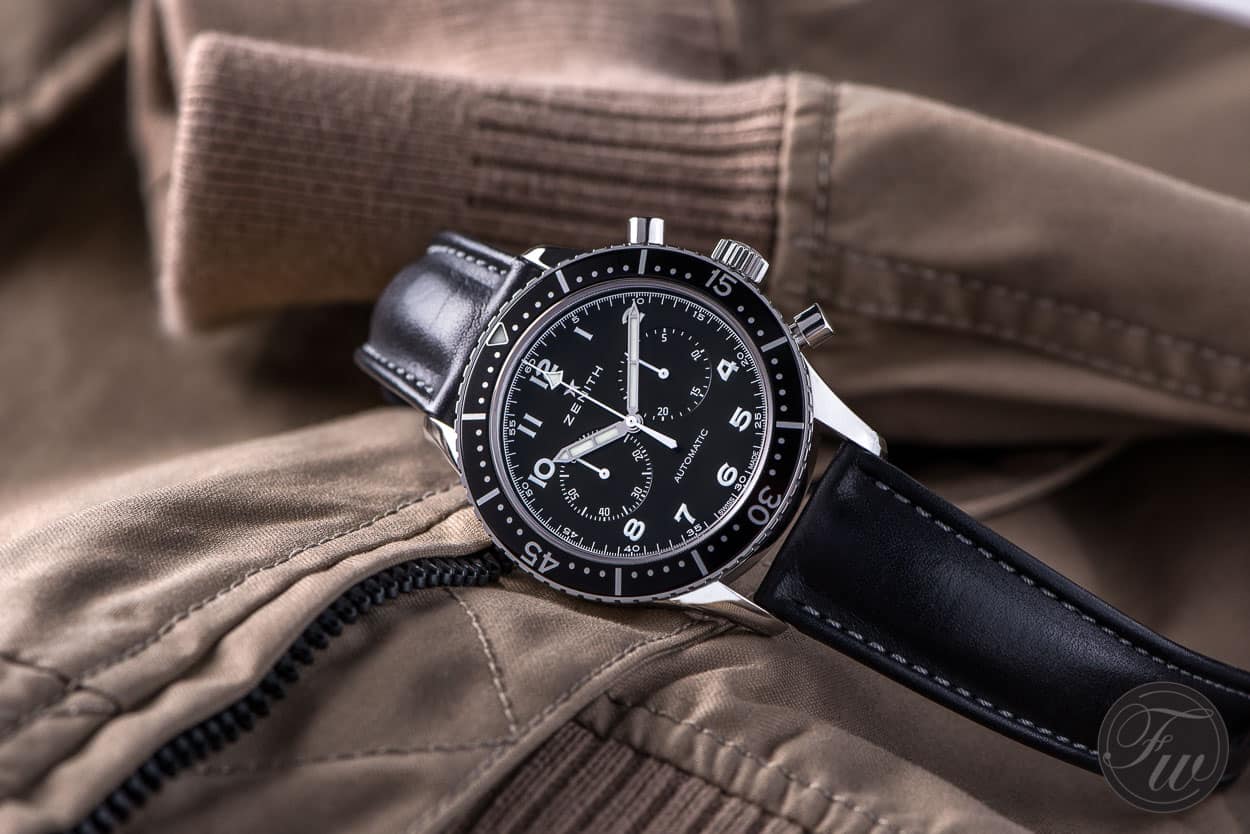Hands-on Zenith Heritage Cronometro TIPO CP-2 Review
Only late in 2016 (October), the famous chronograph manufacturer from Le Locle came out with their Zenith Heritage Cronometro TIPO CP-2. This model refers to the famous (and sought-after) Zenith Cairelli chronographs from the 1960s. A. Cairelli was the Rome-based distributor for a number of watch brands, including Zenith.
Zenith Cronometro TIPO CP-2
The Italian Air Force chose (amongst others) Zenith chronograph for their pilots and Cairelli did the delivery for them. 2500 of these Zenith Cairelli chronographs were delivered to pilots and this original Zenith Cronometro TIPO CP-2 was used by them till the late 1970s. The original version didn’t have an El Primero chronograph movement of course (as these were only introduced in 1969), but a hand-wound caliber DP 146. This was a 1950s movement created by Martel Watch Co, a watch company founded in 1911 and taken over by Zenith in 1959.
Find below an image of the original Zenith Cronometro TIPO CP-2, as offered (and sold) via the Hodinkee Shop. As you can see, the dial is signed “A. Cairelli, Roma.”
CP-2 succeeded CP-1, where “CP” stands for “cronometro da polso” in Italian. No translation needed I guess. The difference between CP-1 and CP-2 is mainly the size, 39mm compared to the 43mm of the latter. Zenith was not the only brand to deliver these CP-2 watches, Leonidas for example also had a CP-2 delivered to the Italian Army, powered by a Valjoux 222 two-register chronograph (more on Leonidas military pieces in this article)
Military watches always could count on a huge interest by collectors (hence books like these are published)
Zenith Heritage Cronometro TIPO CP-2
Now that you know some background information (more here via Zenith) on the Zenith Cronometro TIPO CP-2, and perhaps you already did, it is time to move on to the re-edition that we have here.
If you are not aware of the (military) history of these CP-2 watches or unfamiliar with the “Zenith Cairelli” as the vintage watches are often being referred to, you will probably see just a nice two register chronograph. A bit of knowledge about the history of this piece might increase the understanding why this is a special watch, or at least what the fuss is about. But let’s forget that for a moment (if possible) and have a look at the Zenith Heritage Cronometro TIPO CP-2 watch.
Case
43mm in diameter isn’t exactly a small watch, but not that much bigger than the regular El Primero chronographs (mostly 42mm) and smaller than some of the large pieces Zenith has in their collection (45mm). The 43mm watch wears actually very modest, I would say it wears a tad bit smaller, like 42mm or 41mm. I guess the slender case and absence of crown guards play a role in this perception. The crown (signed with the Zenith star logo) and the pump pushers look awesome and are a joy to use. The polished finish of the case is quite shiny and the lugs have these big facets. The caseback does not reveal the self-winding El Primero movement but instead show a brushed finished surface with the name of the watch engraved.
Personally, I would favor a bit of a brushed finish on top of the case as well, but this new Zenith Heritage Cronometro TIPO CP-2 stays true to the original case, which also had a shiny finish. It is a matter of personal preference of course and at least Zenith stayed true to the CP-2 design. It does make me wonder why pilot’s watches did not receive a brushed finish though, as reflections can be unwelcome in the cockpit.
The bezel has a 60 minute scale and can be used to time certain events. It obviously isn’t meant as a diving bezel, but you can use a minute scale bezel to time other things as well of course. The triangle at 12 o’clock (or ’60’) has been applied with lume.
Dial
The matte black dial of thisZenith Heritage Cronometro TIPO CP-2 has been applied with white painted numerals and scales. The large hour markers (Arabic numerals) are lumed and are clearly readable. The Zenith star at 12 o’clock has ben applied instead of printed, and gives a nice contrast. Instead of using “A. Cairelli, Roma” at 6 o’clock, Zenith chose to use the wording “Automatic” instead. This might have to do with the legal use of that name, although for originality’s sake, I can’t believe this would have been an issue as the company does not exist anymore (nor is the name registered). Anyway, perhaps the lack of this indication doesn’t have to do with legal rights, but with authenticity. This new Zenith Heritage Cronometro TIPO CP-2 has never been delivered or handled by that company, of course. This topic has probably seen some discussions at the Zenith HQ in Le Locle.
The two registers look very well-balanced on the dial. Some large chronographs suffer a bit from being cross-eyed, but not this Zenith Cronometro TIPO CP-2. When you put a small movement in a large case, it is more than logical that everything is a bit more centered on the dial. The space left on the outer section of the dial can be a bit empty that way and then you get these awkward looking pieces. In the past (Thierry Nataf era), some Zenith watches also suffered from this, but no longer. The use of a relatively small movement in a large case also looked awkward when it had a transparent caseback, a complaint I made many times in the (far) past.
On the image below you see a close-up of the dial and hands. The hands really fit the style of the watch and again match the ones used on the original CP-2. Zenith did an excellent job here.
Again, I really like this dial as it is so readable. Unfortunately not all chronographs are as well-designed as this one for example. The CP-2 used to be a real toolwatch, so the dials had to be as clean as possible.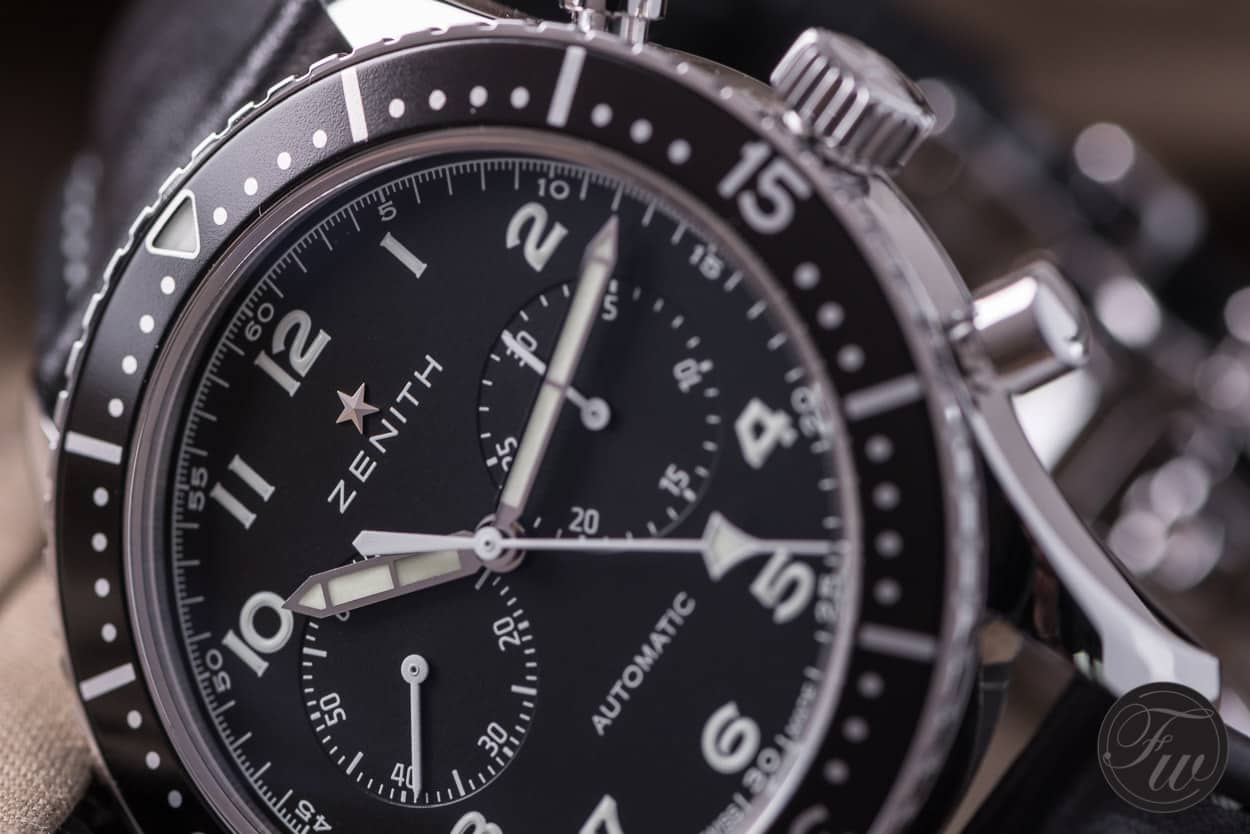
Movement
Unfortunately not a hand-wound, like the original TIPO CP-2, but this alternative is quite good as well. The movement that made Zenith famous in the first place, the El Primero. For this reference 03.2240.4069/21.C774 Zenith used their El Primero 4069 calibre. Shown without the rotor on the drawing below.
- El Primero 4069, Automatic Calibre 131⁄4“` (Diameter: 30 mm)
- Movement thickness : 6.60 mm
- Components : 254
- Jewels: 35
- Frequency: 36,000 A/h (= 5 Hz)
- Power-reserve: Min. 50 hours
- Finishes: Oscillating weight with “Côtes de Genève” motif
You will find the same calibre 4069 used in the Zenith Pilot Ton-Up watch (we reviewed it here) and the Zenith Elite Chronograph Classic (we reviewed that one here). The Ton-Up also didn’t show the movement, but the Elite Chronograph did, as below.
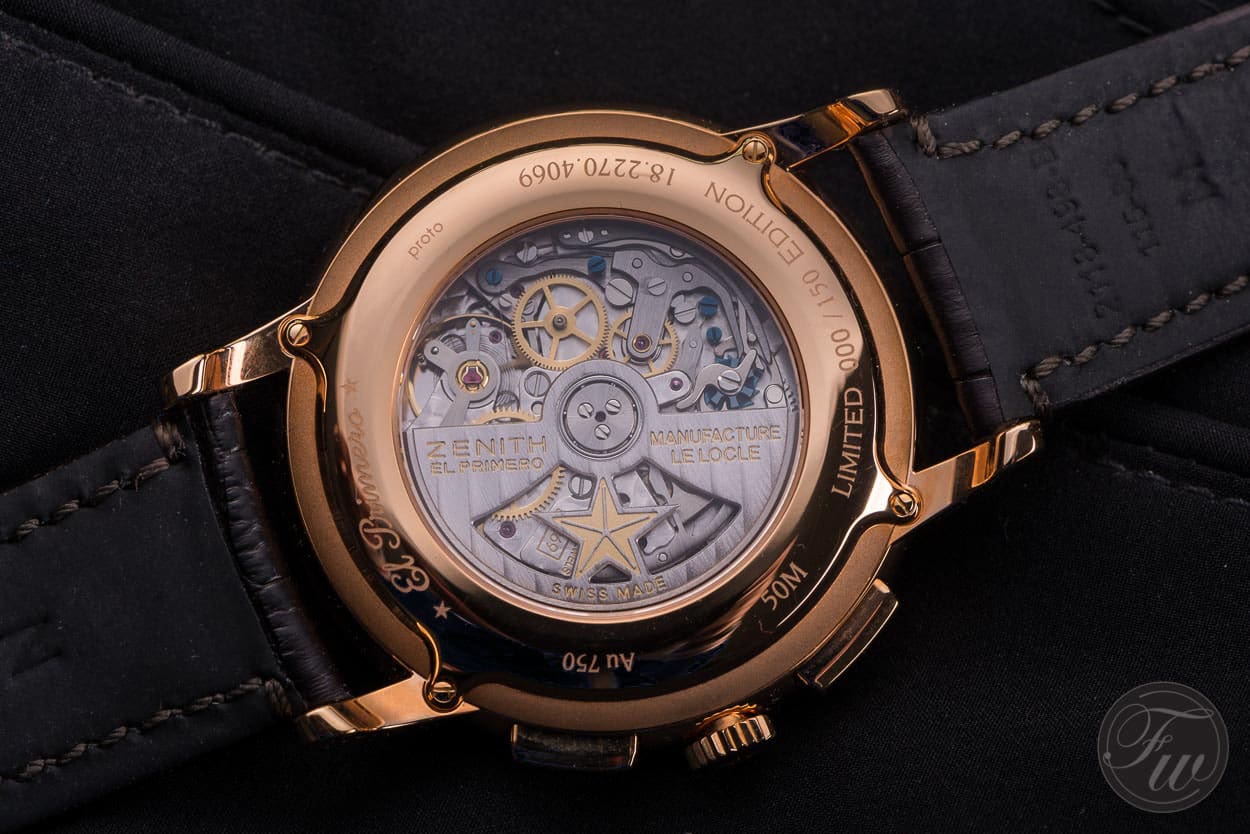
El Primero calibre 4069
The high beat movement remains to be something special in my opinion. The fast ticking sound but also the very smooth second hand (to measure 1/10th of a second) appeals to me and many other watch enthusiasts. To be really honest here, the El Primero movement fascinates me anyway and it is hard to dislike watches that use this movement. Some other brands also used the El Primero movement as you know, like TAG Heuer, Rolex (tweaked down to 28,800vph), Movado and Ebel for example. Some still do.
Some Thoughts
The limited edition Zenith Heritage Cronometro TIPO CP-2 is one of the nicest Zenith models I’ve seen in recent years. That does not mean I don’t like the others (I love those colorful 1969 editions), but I think this is just a very well executed watch. If this is the way forward for Zenith, to come out with some more interesting pieces that are inspired by some of their rich heritage pieces, I applaud them for doing so. One thing that always keeps me puzzled is their chaotic catalog of watches, but I’ve touched that subject before on FW. I hope Jean-Claude Biver can make the difference for Zenith, as it deserves a good and healthy business.
I received the watch on this thick calf strap with folding clasp (I rather see this type of watch on a buckle, but that shouldn’t be a show-stopper) and it wears very comfortably. I can imagine pilots loving this watch so much they wore it all the time actually.
The “action on the pushers” as Mike often says, is very nice, like all El Primero based column-wheel chronograph movements. The 30-minute chronograph is a useful feature and so is the 60 minute bezel. I happen to use my chronographs quite often to time events and it definitely helps if the watch is very readable.
The price tag of 7900 Euro (including 21% sales tax) is a little bit steep in my opinion, but I have no doubts it will sell. There are enough collectors and enthusiasts that love the Zenith A. Cairelli and don’t (or can’t) want to spend a fortune on those, for them this Zenith Heritage Cronometro TIPO CP-2 can be a very interesting alternative.
More information via Zenith on-line.


